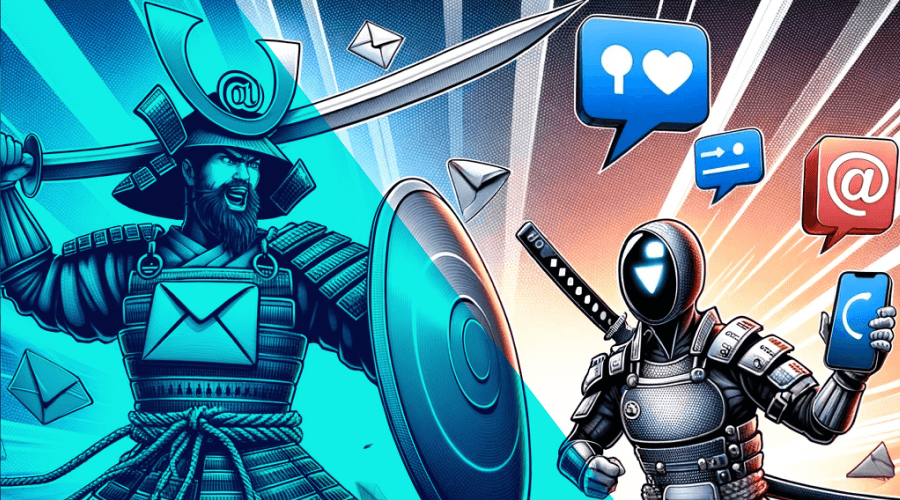Email vs. Push Notifications

Understanding the Key Differences for Effective Marketing

In today’s fast-paced 'martech' landscape, understanding the nuances between different communication channels is crucial for any marketing strategy. Email and push notifications stand out as two of the most effective tools for reaching and engaging audiences. Yet, each channel possesses unique strengths and limitations that can significantly impact your marketing outcomes. For marketers aiming to create a seamless and impactful omni-channel experience, recognizing when and how to use each medium can transform customer interactions from ordinary to extraordinary. This blog will explore the critical differences between email and push notifications, providing insights into how to leverage each for maximum engagement.
1. Opt-In Dynamics: The Gateway to Personalization
Opting into email communications typically involves a user providing a known email address, which not only permits direct communication but also enhances personalization opportunities. This direct line to the user fosters a more formal and established connection, allowing marketers to tailor their messages based on the recipient's known preferences and history with the brand.
Conversely, push notifications require a user to allow messages from apps or websites on their devices, linked not to an email address but to a unique token specific to the device or browser. It allows for anonymous communication with minimal intrusion. Once signed in or signed up, the anonymous communication can be connected to a user profile. Push notifications are ideal for real-time interaction and can be used for timely announcements.
2. User Experience: Where Messages Live
Emails reside in a user's email client, becoming part of their broader digital ecosystem, which they typically check several times throughout the day. This permanence allows users to engage with content at their convenience, making email suitable for detailed messages that require thoughtful consideration.
Push notifications appear directly on a user's device screen, offering immediate visibility. Unlike emails, these notifications are meant to be digested quickly, providing just enough information to prompt immediate action or awareness. This makes Push an excellent channel for time-sensitive alerts and engaging users on the go.
Remember, the key to successful in-app messaging lies in balance. Your messages should add value to the user experience, not detract from it.
3. Timing and Content: Crafting the Message
Emails afford the luxury of length and detail, facilitating comprehensive communication that can cover multiple topics, include images, and incorporate multiple calls-to-action. This channel is perfect for delivering content that benefits from deeper engagement, such as newsletters, product updates, or promotional campaigns.
Push notifications, on the other hand, are by necessity short and focused. Limited to brief texts, they must convey the message succinctly but compellingly. This brevity is perfect for quick updates, alerts, or nudges to draw users back into apps or websites, often personalized to the user’s immediate context, like their location or activity.
4. Context and Personalization: Leveraging Real-Time Data
While emails can be personalized based on past user data, they, most of the time, lack the ability to adapt in real-time. Marketers can, of course, segment their audience and craft messages that resonate with different user groups.
Push notifications excel in their ability to utilize real-time data. This might include a user’s location, the time of day, a click on a button, or interaction with NFC tags. Such dynamic personalization allows marketers to send highly relevant and contextually appropriate messages, enhancing the user experience and increasing the likelihood of engagement.
5. Analyzing the Impact: Engagement and Response Metrics
The Email channel provides detailed analytics, including delivery rates, open rates and click-through rates. These metrics offer valuable insights into user engagement and the effectiveness of email campaigns, allowing marketers to fine-tune their strategies.
While push notifications can report delivery and open rates, they lack the depth of read tracking available with emails. Marketers can see the immediate impact of interaction with a notification, such as app opens or website visits triggered by a push, but both iOS and Android can't provide if a message was read on lockgreen.
Conclusion: Integrating Email and Push Notifications into Your Marketing Strategy
Both email and push notifications are indispensable channels for marketers seeking to create a comprehensive omni-channel strategy. By understanding the unique benefits and limitations of each, marketers can craft a nuanced approach that enhances customer engagement across all touchpoints. Combining the detailed, deliberate nature of email with the immediate, context-sensitive allure of push notifications can lead to a more coherent and effective customer experience. For more insights or to develop a tailored strategy that incorporates both email and push notifications, consider contacting our Professional Services.
